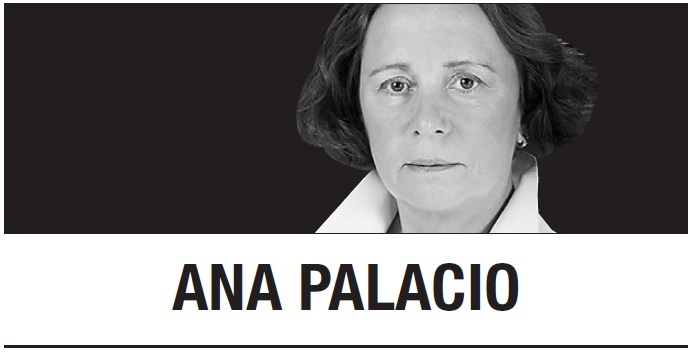[Ana Palacio] Has Putin reversed Nixon in China relations?
By Korea HeraldPublished : Feb. 22, 2022 - 05:31

Even if Russian President Vladimir Putin withdraws some of the troops massed near Ukraine’s border and a diplomatic solution to the standoff with the West averts a Russian invasion, tensions between Russia and the West will not disappear any time soon. Nor will the Kremlin’s efforts to deepen Russia’s ties with China.
The rapprochement between China and Russia, which began with the 2001 Treaty of Friendship, has been slow but steady. It received a boost after Russia’s 2014 invasion and annexation of Crimea, with Putin (somewhat reluctantly) pivoting to the East, including by signing a 30-year, $400 billion deal to deliver gas to China.
Nonetheless, Russia and China have remained broadly reluctant to be drawn into each other’s fights. Despite the gas deal, China was hesitant to endorse the invasion of Crimea, nor has it backed Russia’s foreign adventures elsewhere, such as in Georgia. So, it was notable when, last month, China expressed support for Russia’s aggressive moves toward Ukraine, arguing that Russia’s “legitimate security concerns” must be “taken seriously.”
A little more than a week later, Russia and China went much further, issuing a joint declaration on “international relations entering a new era.” While the Chinese Foreign Ministry published only a 1,200-word summary of the meeting, Russia published a 5,000-word text that displays a level of detail and scope not previously seen in the bilateral relationship.
The Russian text covers a wide range of topics, from the pursuit of “true multilateralism” to the expansion of bilateral cooperation in such areas as the “sustainable development of the Arctic,” the manufacture of COVID-19 vaccines, and security. While the pact stops short of mutual defense, it announces that Russia and China will work together to oppose “attempts by external forces to undermine security and stability in their common adjacent regions.”
Both sides reaffirm their “strong mutual support for the protection of their core interests, state sovereignty, and territorial integrity,” with Russia reaffirming its support for the One China policy and China declaring its opposition to NATO enlargement.
It may be tempting to brush off these lofty pronouncements. And, in fact, pundits often have dismissed the notion that there is a “growing kinship” between America’s “top rivals.” They highlight how complex the relationship is, and they caution that perceptions inevitably shape reality.
It is true that Russia and China have historically had uneasy ties, exemplified by the Sino-Soviet split in 1960, which Nixon sought to cement 12 years later. Today, major sources of tension remain, including in Central Asia, Africa, and the Arctic. Russia’s intervention in Kazakhstan last month is unlikely to have pleased China. Meanwhile, Putin is keenly aware of the economic asymmetries and China’s rising geopolitical influence in what he considers Russia’s backyard.
So, the Russia-China nexus is most likely a marriage of convenience. It would hardly be the first time two countries that are complementary only through the lens of realpolitik -- in this case an economic giant that might soon overtake the US in conventional military capabilities and a hydrocarbon-rich nuclear-armed state spanning 11 time zones -- have agreed to cooperate.
But Russia and China need not be perfect allies for their relationship to disrupt the international order -- and they know it. Their decision to express a joint, alternative vision signals a dramatic change in tone and tack.
While Russia has never shied away from challenging the international order, China has avoided showing open hostility toward it. Instead, it has publicly touted multilateralism and even democratic tradition, but a version based on “unique cultural characteristics.” It has used the language of the international order to usurp that order, by imbuing it with meanings that reflect China’s own ambitions.
Russia lately seems to be employing the same tactic in its standoff. And with the Feb. 4 declaration, China seems to be endorsing Russia’s more assertive approach, perhaps in preparation for a foray into Taiwan. More broadly, the alternative vision for the global order that Russia and China are advancing could influence other countries, including in Europe’s neighborhood.
The West, together with its democratic partners and allies in Asia, should be thinking carefully about how to counter this “alliance of autocracies.” And yet, locked in competition with China, the US is not in a position to pull a Nixon-style diplomatic coup. Meanwhile, Europe remains riven by internal divisions and torn between aspirations for strategic unity and the false hope that it can achieve this by muddling through.
Economic engagement will not be enough to hold back the tide. The world’s democracies, led by the US and Europe, must work together to restore the prestige of the rules-based international order and to imbue the principles and practices of multilateralism with their true meaning. Unless and until that happens, the alternate vision put forth by the world’s autocracies will continue to gain ground.
Ana Palacio
Ana Palacio, a former minister of foreign affairs of Spain and former senior vice president and general counsel of the World Bank Group, is a visiting lecturer at Georgetown University. -- Ed.
(Project Syndicate)
-
Articles by Korea Herald



![[AtoZ into Korean mind] Humor in Korea: Navigating the line between what's funny and not](http://res.heraldm.com/phpwas/restmb_idxmake.php?idx=644&simg=/content/image/2024/04/22/20240422050642_0.jpg&u=)


![[Exclusive] Korean military set to ban iPhones over 'security' concerns](http://res.heraldm.com/phpwas/restmb_idxmake.php?idx=644&simg=/content/image/2024/04/23/20240423050599_0.jpg&u=20240423183955)
![[Herald Interview] Why Toss invited hackers to penetrate its system](http://res.heraldm.com/phpwas/restmb_idxmake.php?idx=644&simg=/content/image/2024/04/22/20240422050569_0.jpg&u=20240422150649)
![[Graphic News] 77% of young Koreans still financially dependent](http://res.heraldm.com/phpwas/restmb_idxmake.php?idx=644&simg=/content/image/2024/04/22/20240422050762_0.gif&u=)







![[Exclusive] Korean military to ban iPhones over security issues](http://res.heraldm.com/phpwas/restmb_idxmake.php?idx=652&simg=/content/image/2024/04/23/20240423050599_0.jpg&u=20240423183955)



![[Today’s K-pop] Ateez confirms US tour details](http://res.heraldm.com/phpwas/restmb_idxmake.php?idx=642&simg=/content/image/2024/04/23/20240423050700_0.jpg&u=)